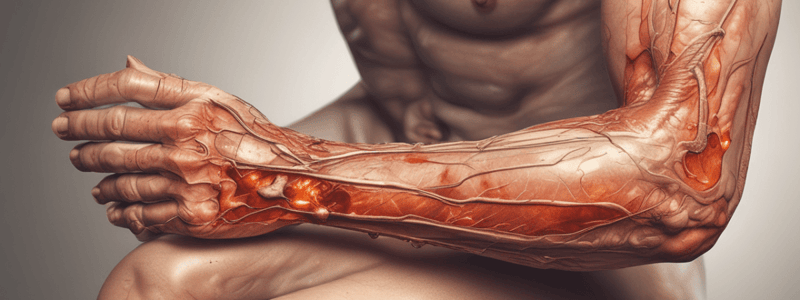Podcast
Questions and Answers
What is the estimated number of people who seek medical treatment for burns annually?
What is the estimated number of people who seek medical treatment for burns annually?
- 6 million (correct)
- 12 million
- 3 million
- 9 million
Where do most burn injuries occur?
Where do most burn injuries occur?
- In outdoor recreational areas
- In public places
- In the home (correct)
- In the workplace
What is the function of the skin in the body?
What is the function of the skin in the body?
- It is responsible for regulating body temperature
- It is responsible for producing vitamin D
- It is the first line of defense (correct)
- It is the second line of defense
What is the ranking of fire and burn injuries as a cause of death in children between 1-4 years?
What is the ranking of fire and burn injuries as a cause of death in children between 1-4 years?
What is the weight of the skin in the average person?
What is the weight of the skin in the average person?
What percentage of resting cardiac output is received by the skin?
What percentage of resting cardiac output is received by the skin?
What is the primary function of the subcutaneous tissue in relation to the body's structure?
What is the primary function of the subcutaneous tissue in relation to the body's structure?
Which of the following vitamins are stored in the adipose tissue of the subcutaneous layer?
Which of the following vitamins are stored in the adipose tissue of the subcutaneous layer?
What is the effect of aging on the subcutaneous fat on the legs or forearms?
What is the effect of aging on the subcutaneous fat on the legs or forearms?
Which layer of the skin provides a physical and chemical barrier?
Which layer of the skin provides a physical and chemical barrier?
What is the function of the deeper lymphatic vessels located within the subcutaneous tissue?
What is the function of the deeper lymphatic vessels located within the subcutaneous tissue?
What is the effect of aging on the number of sweat glands in the skin?
What is the effect of aging on the number of sweat glands in the skin?
What is the consequence of fat loss from the subcutaneous tissue?
What is the consequence of fat loss from the subcutaneous tissue?
What is the annual rate of collagen content decrease in the skin throughout adult life?
What is the annual rate of collagen content decrease in the skin throughout adult life?
What is the type of necrosis that occurs in acidic burns?
What is the type of necrosis that occurs in acidic burns?
What is the reason why alkaline burns are more severe than acidic burns?
What is the reason why alkaline burns are more severe than acidic burns?
What is the factor that determines the extent of electrical burn injury?
What is the factor that determines the extent of electrical burn injury?
What is a potential complication of chemical spills, in addition to cutaneous damage?
What is a potential complication of chemical spills, in addition to cutaneous damage?
What is the primary reason for the limitation of mobility in patients with burn injuries?
What is the primary reason for the limitation of mobility in patients with burn injuries?
What is the purpose of active range of motion assessment in burn injury patients?
What is the purpose of active range of motion assessment in burn injury patients?
What is the medical decision that affects the patient's ability to walk after a burn injury?
What is the medical decision that affects the patient's ability to walk after a burn injury?
What is the primary factor that affects the aerobic capacity of patients with burn injuries?
What is the primary factor that affects the aerobic capacity of patients with burn injuries?
What is the purpose of functional activities assessment in burn injury patients?
What is the purpose of functional activities assessment in burn injury patients?
What is the long-term psychological effect that can occur in patients with burn injuries up to 2 years after the injury?
What is the long-term psychological effect that can occur in patients with burn injuries up to 2 years after the injury?
What is the primary principle behind the Volumetric Measurement Method?
What is the primary principle behind the Volumetric Measurement Method?
What is the main disadvantage of the water displacement method?
What is the main disadvantage of the water displacement method?
What is the characteristic of Grade 2+ pitting edema?
What is the characteristic of Grade 2+ pitting edema?
What is the purpose of limb circumference comparison?
What is the purpose of limb circumference comparison?
What is the advantage of girth measurement?
What is the advantage of girth measurement?
What is the characteristic of Grade 0+ edema?
What is the characteristic of Grade 0+ edema?
Flashcards are hidden until you start studying
Study Notes
Anatomy and Function of Integumentary System
- The skin is the largest organ of the body, weighing around 4-5 kg in the average person.
- It receives roughly one-third of resting cardiac output.
- The thinnest skin is located on the eyelids and eardrums, while the thickest skin is located on the palms of the hands and the soles of the feet.
- The skin has several functions, including:
- Protection
- Sensations
- Synthesis of vitamin D
- Excretion of wastes
- Temperature regulation
- Determines characteristics
Functions of Skin Layers
- Epidermis:
- Provides a physical and chemical barrier
- Supports and nourishes epidermis
- Regulates fluid
- Houses epidermal appendages
- Provides light touch sensation
- Assists with thermoregulation
- Assists with infection control
- Assists with excretion
- Critical to endogenous vitamin D production
- Dermis:
- Provides sensation
- Contributes to cosmesis/appearance
- Subcutaneous tissue (Hypodermis):
- Gives smoothness and contour to the body
- Contains fat for use as energy production
- Provides insulation for body
- Mechanical shock absorber
- Fat-soluble vitamins (A, D, E, and K) are stored in adipose tissue
Age-Related Changes in Skin
- Sweat glands diminish in number
- Atrophy of epithelial and fatty layers of tissue
- Diminishing of subcutaneous fat on the legs or forearms
- Fat loss from the subcutaneous tissue causes relative prominence of bony protuberances
- Collagen and elastin shrink and degenerate
- Collagen content of the skin decreases by approximately 1% per year throughout adult life
- Net effect: thin, dry, and inelastic skin susceptible to separation of dermis and epidermis
Burn Injuries
- Definition: Coagulation destruction of skin or other body parts due to thermal, chemical, electrical, irradiation, or atomic causes.
- Etiology: Types of burn injuries include thermal, chemical, electrical, and irradiation burns.
- Chemical burns:
- Acidic burns: Occur when acidic chemicals come in contact with the skin, causing coagulation necrosis and limiting the extent of tissue injury.
- Alkaline burns: Occur when alkaline chemicals denature the proteins within the skin, causing liquefaction necrosis and deeper penetration of tissue damage.
Burn Injury Assessment
- Edema assessment:
- By observation and comparison to the sound limb
- By palpation to determine the type of edema (pitting or non-pitting)
- By measurement using water displacement, girth measurement, or ring method
- Volumetric measurement method:
- Gold standard tool for measuring edema
- Utilizes the principle of water displacement
- Disadvantages: time-consuming, difficult to move, requires specialized equipment, and messy
- Flexibility assessment:
- Active range of motion assessment to determine whether the patient can move in a pain-free range of motion without pain in the joints
- Used to assess whether individual muscles or groups may need flexibility training
- Mobility and ambulation assessment:
- Ability to move in bed
- Ability to transfer out of bed
- Note gait deviations
- Endurance assessment:
- Cardiovascular endurance is limited due to systemic and catabolic effects of burn injury
- Aerobic capacity of the patient is affected by bed rest, immobilization, and pain
- Encourage patient to ambulate as early as possible
- Functional activities assessment:
- Assess patient's ability to perform ADL (activities of daily living)
- Neurological and psychological factors assessment:
- Burn injury can cause negative long-term psychological effects such as acute stress disorder, depression, suicidal ideation, and post-traumatic stress disorder for as long as 2 years after injury.
Studying That Suits You
Use AI to generate personalized quizzes and flashcards to suit your learning preferences.



